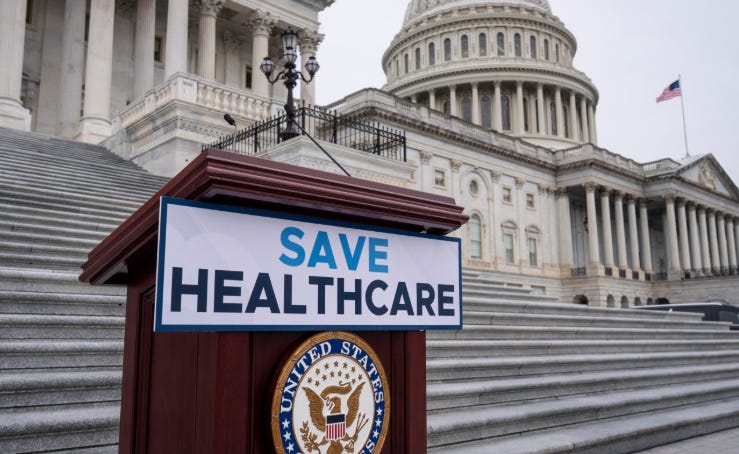EDITOR’S NOTE: Here’s an installment from Tillamook County’s State Representative Cyrus Javadi’s Substack blog, “A Point of Personal Privilege.” Oregon legislator and local dentist. Representing District 32, a focus on practical policies and community well-being. This space offers insights on state issues, reflections on leadership, and stories from the Oregon coast, fostering thoughtful dialogue. Posted on Substack, 11/24/25
It’s What Happens When Everyone Pays Less Than the Bill
By State Representative Cyrus Javadi
Last week, legislators trekked back to Salem for “legislative days” to find out which problem grew teeth while we were gone.
What did we find? That healthcare’s teeth aren’t looking so great. Or more accurately, healthcare may need a full set of dentures.
Oregon hospitals alone lost $300 million in the first quarter of 2025¹. Nearly half of our hospitals are losing money, and more than 70% say they can’t maintain current service levels².
That’s administrator-speak for: “Houston, we have a problem.”
And while hospitals are shedding cash, another crisis is not-so-quietly barreling toward some of us.
In January 2026, tens of thousands of Oregonians will open their renewal letters and discover their individual-market premiums have doubled, tripled, or even quadrupled, because the enhanced ACA subsidies Congress expanded in 2021 are expiring⁴.
Predictably, when I mentioned the likely end of the enhanced subsidies on Facebook last week, the internet delivered its usual blend of confidence and guesswork.
“Ending subsidies will discipline the market! And, finally lower premiums!”
“Obamacare caused all of this! It’s the Democrats fault!”
“Subsidies are handouts to insurers! Get rid of them!”
Are these statements on or off the mark? As you’d guess, the answer to that question is both simple and complicated.
If want to know why and how, and you’re looking for a topic to be ready to discuss during your Thanksgiving feast this week, read on dear reader. Read on.
The Root of the Crisis
When people complain about premiums, they’re not wrong. Premiums really are high. The kind of high that makes you stare at the renewal letter like it’s personally offended you. But premiums only tell you what families pay. They don’t tell you what it actually costs to deliver care.
It’s like going out to dinner. You order your meal, enjoy it, and eventually the bill shows up. That number tells you what dinner cost you. It doesn’t tell you what it cost the restaurant to buy ingredients, pay staff, keep the lights on, or fix the oven that only breaks on Saturday nights. Restaurants need their menu prices to cover those costs. Hospitals need premiums to do the same thing.
And for a long time, those two numbers (what families pay and what it costs to deliver care) lived in the same neighborhood. “Besties,” as my kids would say.
But not anymore. And that growing distance is the root of the crisis.
The Big Pot of Money We All Rely On
Before we get to the part where everything falls apart, it helps to remember how health insurance is supposed to work in the first place.
Picture a group of 1,000 people. A normal slice of American life. Some old, some young. Some men, some women. A lot of kids. Some in perfect health. Some managing chronic conditions. A few who will fall off ladders or get into car accidents. Others who will deliver babies or suffer heart attacks. All will eventually need medical care.
Some of these people won’t see a doctor this year. Some will skip therapy they should attend. Some will breeze through the year without so much as a prescription refill.
But here’s the key: they all still need to pay into the pot.
Health insurance (the kind that actually works) is one giant pot of money. Some comes from employers. Some from employees. Some from the government. And that pot has one job:
To pay the medical bills hospitals and clinics will submit next year.
THE VIEW FROM A KITCHEN TABLE
Imagine a single mom in Nehalem, Knappa, or Netarts. She puts the kids to bed, sits down at the table, opens her insurance renewal letter, and sees her $420 premium has become $1,600 a month.
Cue frustration. Cue confusion. Cue anxiety.
The next week she takes her daughter to the clinic and sees a sign taped to the door:
“Due to staffing shortages, wait times may be longer than usual.”
If hospitals are supposedly awash in cash, why can’t they hire? Why is her doctor leaving? Why are there fewer nurses in the hallway?
Because here’s what she can’t see from her kitchen table:
Since 2019, the cost of delivering care has exploded.
Hospital labor up 21–25%.
Medical supplies 18–20%.
Equipment 12–15%.
Hospital construction 25–30%.
Travel nurses 200% above baseline⁵.
Meanwhile, Oregon hospitals’ average operating margin sits at 0.3%⁷. If that seems small, it’s because it is.
This isn’t a system where hospitals are rolling in cash, they are bleeding it.
What can be done? Good question. And this is where insurers and the government factor in.
When Half the System Pays Half the Bill
Most people don’t know Medicaid reimburses Oregon hospitals around 56 cents for every $1 it costs to deliver care⁸. Medicare pays a little better, but still below cost. In many Oregon communities (especially rural ones), a majority of patients fall into these categories.
If half your customers paid you only 56% of the cost of your ingredients, labor, rent, and utilities, you’d only stay open if you charged the other half of your customers a lot more.
In other words, commercial insurance is making up the difference. How? In two ways. First, by charging higher premiums, commercial insurance policies can pay providers 1.5x more for the service than it actually costs. And, second, the federal government is helping people pay these higher premiums through the ACA subsidies.
But here’s the rub. Commercial enrollment in America is shrinking. Why? Because Oregon is aging, and more are qualifying for Medicare (in other words, they aren’t paying insurance companies premiums anymore). And, also, employers are dropping coverage, because it’s too expensive.
In other words, less people are paying into the pot, making everyone who is still paying, pay more.
That’s the math. No ideology required. Just arithmetic, and Advil.
THE HUMAN CONSEQUENCES
If you want to understand the stakes, don’t look at charts. Look at Oregon.
Half our hospitals are losing money². More than 70% cannot sustain current services². We lost $300 million in one quarter¹.
And Oregon isn’t unique.
Across the country, more than 400 rural hospitals are at risk of closure³.
One small hospital in Northern California, not far from our own rural communities, shut down last year, leaving 28,000 people without an ER⁹.
If your kid breaks his arm, the drive is now 5 hours instead of 60 minutes.
If your mother has a stroke, the odds worsen by the mile.
If your neighbor has a heart attack, seconds matter, and you’ve just lost them.
Healthcare is not a spreadsheet.
It’s geography.
It’s time.
It’s staffing.
It’s luck.
And the luck is running out.
The Funny, Not-So-Funny Reality
Here’s the funny part, and by funny I really mean the not-so-funny-but-kind-of-tragic sense of the word: None of this should be surprising.
The crisis we’re facing isn’t the result of one decision, one law, or one political party. It’s the collision of rising costs, shrinking margins, government underpayment, an aging population, and a nation with the chronic-disease profile of a stressed-out superpower.
It’s what happens when the price of delivering care grows faster than the ability (or, honestly, the willingness) of any part of the system to pay for it.
If you’re willing to come with me, the next article will take you behind the scenes into how insurance was supposed to work, the factors driving the skyrocketing costs of delivering care, the goal of Obamacare, where I think healthcare in Oregon and the United States is heading, and what we can do about it.
Because once you see the true cost of delivering care, you won’t just understand the crisis.
You’ll understand why pretending it’s anything else is its own kind of moral failure.
FOOTNOTES
1. Oregon hospitals losing ~$300M in Q1 2025 — Willamette Week (2025).
2. ~50% of Oregon hospitals losing money; 70% lack resources — Oregon Association of Hospitals (2025).
3. Rural hospitals at risk — U.S. Senate rural hospital risk analysis (2025).
4. ACA subsidy expiration impact — KFF & Investopedia (2025).
5. Cost inflation data — National healthcare cost reports (2019–2024).
6. Median hospital margins ~0–2% — Kaufman Hall (2023–2024).
7. Oregon hospital margin (~0.3%) — The Lund Report (2024).
8. Medicaid reimbursing ~56¢ per $1 — Oregon Capital Chronicle (2025).
9. Northern California hospital closure — The Guardian (2025).
Subscribe to the Substack
I write about hard problems every week. From healthcare to transportation to the constitutional guardrails that keep this whole American experiment stitched together.
If you want the next part of this series (and everything after it), you can subscribe below. It’s free, it’s independent, and it’s one of the few places left where nuance hasn’t gone into early retirement.


